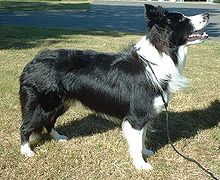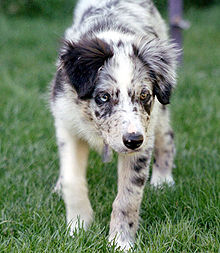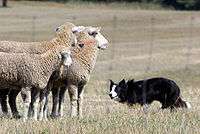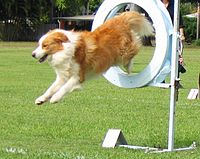Border Collie
| Border Collie | |||||||||
|---|---|---|---|---|---|---|---|---|---|
 Border Collie | |||||||||
| Origin | United Kingdom | ||||||||
| |||||||||
| Dog (domestic dog) | |||||||||
The Border Collie is a hardworking breed of herding dog that originated in the border country of England and Scotland. They are regarded by many as the most intelligent dog breed. [1] Border Collies are highly energetic, and as a result have a tendency towards neurotic or destructive behavior if not given enough to do. They are still frequently used on farms all over the world for assisting with the handling of livestock, and they have also become popular as pet and sport dogs. Though known to be reserved with strangers, these dogs can also be protective of a human family member and affectionate to those they know.
Appearance

Border Collies have historically been bred for working ability rather than looks, and therefore vary widely in appearance.
In general, Border Collies are medium-sized dogs without extreme physical characteristics and a moderate amount of coat. Their double coats can be anywhere from slick to lush, and can come in many colours, although black and white is by far the most common, and therefore the most common in public perception. Black tricolour (black/tan/white) and red and white also occur regularly, with other colours such as blue and white, red merle, blue merle, "Australian red," and sable seen less frequently. White Border Collies are not very common.

Eye colour varies from deep brown to amber or blue with occasionally one eye of each colour, usually seen with merles. The ears of the Border Collie are also highly variable — some have fully erect ears, some fully dropped and others are semi-erect (similar to that of the Rough Collie). Although working Border Collie handlers sometimes have superstitions about the appearance of their dogs (handlers do not prefer red dogs, or mostly white dogs),[citation needed] in general a dog's appearance is considered to be irrelevant. It is considered much more useful to identify a working Border Collie by its attitude and ability than by its looks.
Those dogs bred for the conformation ring are more homogeneous in appearance than working Border Collies, since to be successful show dogs they must conform to breed club standards that are specific on many points of the structure, coat and colour. Kennel clubs specify, for example, that the Border Collie must have a "keen and intelligent" expression, and that the preferred eye colour is dark brown. In deference to the dog's working origin, scars and broken teeth received in the line of duty are not to be counted against a Border Collie in the show ring, but in practice breed ring dogs are rarely used for working livestock.
Height at withers: Males from 19" to 22", Females from 18" to 21".[citation needed]
Temperament
The Border Collie is an extremely intelligent, biddable breed with an instinctive desire to work closely and intensely with a human handler.[2] Although the primary role of the Border Collie is that of the working stock dog, dogs of this breed are becoming increasingly popular as pets. True to their working heritage, Border Collies make very demanding, energetic pets that are better off in households that can provide them with plenty of exercise and a job to do. Among some breeders in the United Kingdom there is a common saying: "no sheep, no collie", referring to the dog's usual unsuitability to people who just want a "smart dog."[3] However, in an appropriate home, with a dedicated, active owner, a Border Collie can be an excellent companion.[4] Participating in dog sports [5] is popular with Border Collie owners.
Border Collies are unsuitable pets for people who cannot or will not provide a considerable amount of daily exercise for their dogs, both physical and mental. They are also a poor choice for households that are not prepared for the characteristic behaviors that are part of their working heritage. For example, as with many working breeds, Border Collies can be motion-sensitive and may attempt to control the movements of family members, cats, squirrels, bicycles, cars, or anything else that moves if not given enough mental and physical stimulation. These dogs are also not suitable for households with small children, because they frequently try to "guide" the children or react rather quickly to unexpected movements. Many Border Collies who end up in shelters or rescue groups are there because owners, who may have been attracted by their appearance and intelligence, were not prepared to meet their dog's needs.[6]
Health
Hip dysplasia, Collie eye anomaly (CEA), and epilepsy are considered the primary genetic diseases of concern in the breed at this time.[7] Collie eye anomaly (CEA) is a congenital, inherited eye disease affecting Border Collies and other breeds involving the retina, choroid, and sclera. In Border Collies, it is generally a mild disease and rarely significantly impairs vision. There is now a DNA test available for CEA[8] and, through its use, breeders can ensure that they will not produce affected pups. There are no genetic tests available for hip dysplasia or epilepsy, although careful breeding practices are known to lower the incidence of both.
Elbow dysplasia or Osteochondritis, deafness, and hypothyroidism may also occur in the breed. Dogs homozygous for the merle gene are likely to have eye and/or hearing problems. Responsible breeders do not mate merles to one another.
Neuronal ceroid lipofuscinosis (NCL) is a rare but serious disease. CL results in severe neurological impairment and early death; afflicted dogs rarely survive beyond two years of age. The mutation causing the form of the disease found in Border Collies was identified in the laboratory of Dr. Alan Wilton of the School of Biotechnology and Biomolecular Sciences, University of New South Wales, Sydney, Australia.[9] There is no treatment or cure, but a DNA test is now available to detect carriers as well as affected dogs.
Trapped Neutrophil Syndrome (TNS) [10] is a hereditary disease which inhibits the release of neutrophils produced in the bone marrow into the blood stream. Puppies affected with this disease will eventually succumb to infection. Because this is an autoimmune-deficiency disease the puppies present a variety of symptoms depending upon what infections they fall prone to, and so it has gone undiagnosed in the past. Once thought to be rare, it is now believed to be responsible for many cases of "fading puppies". There is no cure, but a DNA test is now available to detect carriers as well as affected dogs. [11]
History
Origins

The Border Collie is descended from droving and gathering breeds originating on the Scottish and English border. Mention of the 'Collie' or 'Colley' type first appeared toward the end of the nineteenth century with every current Border Collie tracing back to a dog known as Old Hemp. Old Hemp, a tri-colour dog, was born September 1893 and died May 1901. He was bred by Adam Telfer from Roy, a black and tan dog, and Meg, a black-coated, strong-eyed bitch. Hemp was a quiet, powerful dog that sheep responded to easily. Many shepherds used him for stud on their bitches, and Hemp's working style became the Border Collie style.
Wiston Cap is the dog that the International Sheep Dog Society (ISDS) badge portrays in the characteristic Border Collie herding pose. He was the most popular stud dog in the history of the breed, and appears in a huge percentage of pedigrees today. Bred by W. S. Hetherington and trained and handled by John Richardson, Cap was a biddable and good-natured dog. His bloodlines all trace back to the early registered dogs of the stud book, and to J. M. Wilson's Cap, who occurs sixteen times within seven generations in his pedigree. Wiston Cap sired three Supreme Champions and is grand-sire of three others, one of whom was E. W. Edwards' Bill, who won the championship twice.
These dogs were traditionally known simply as "collies," but terms like working collie, old-fashioned collie, and farm collie have also been applied to them. It was in 1915 that James Reid, Secretary of the International Sheep Dog Society in the United Kingdom, first used the term "Border Collie" to distinguish those dogs registered by the ISDS from the Kennel Club's "Collie," which originally came from the same working stock but had developed a different, standardised appearance following its introduction to the show ring in 1860.[12]
Breed standards
As is the case with many breeds of dogs that are still used for their original purposes, breed standards vary depending on whether the registry is more interested in a dog that performs its job superbly or a dog whose appearance meets an ideal standard.
There are two types of tests, or standards, to determine the breeding quality of a Border Collie. The original test was the ISDS sheepdog trial, still used today, where a dog and handler collect groups of livestock and move them quietly around a course. The 'standard' comes from the fact that, the world over, there are certain standard elements to this test. Sheep must be gathered without being too much disturbed, from a distance farther than the typical small airport runway. They then must be directed through obstacles at varying distance from the handler, and then the dog must demonstrate the ability to do work close at hand by penning the sheep and sorting them out. It is these elements which have shaped the working abilities of the Border Collie and defined the breed. These dogs are necessarily capable of incredible feats of athleticism, endurance, intense focus, and high levels of trainability.
In nearly every region of the world, the Border Collie is now also a breed which is shown in ring or bench shows. For the people who participate in these events, the Border Collie is defined by the breed standard, which is a description of how the dog should look. Temperament is also a major consideration for show dogs. In New Zealand and Australia, where the breed has been shown throughout most of the twentieth century, the Border Collie standards have produced a dog with the longer double coat (smooth coats are allowed), a soft dark eye, a body slightly longer than tall, a well-defined stop, as well as a gentle and friendly temperament. This style of Border Collie has become popular in winning show kennels around the world, as well as among prestigious judges.

Few handlers of working Border Collies participate in conformation shows as working dogs are bred to a performance standard rather than one based on appearance. Likewise, conformation-bred dogs are seldom seen on the sheepdog trial field, except in Kennel Club-sponsored events. Dogs registered with either working or conformation based registries are seen in other performance events such as agility, obedience, tracking or flyball, however these dogs do not necessarily conform to the breed standard of appearance as closely as the dogs shown in the breed rings as this is not a requirement in performance events, nor do they necessarily participate in herding activities.
Registries
In the UK, there are two separate registries for Border Collies. The International Sheep Dog Society[13] encourages breeding for herding ability, whereas the Kennel Club (UK) encourages breeding for a specific appearance. The ISDS registry is by far the older of the two, and ISDS dogs are eligible for registration as pedigree Border Collies with the Kennel Club (KC) — but not vice versa. The only way for a Border Collie without an ISDS pedigree to be added to the ISDS registry is by proving its worth as a herding dog and that it dosen't have any health problems, so that it can be Registered on Merit (ROM).
In the United States, the majority of Border Collies are registered with the American Border Collie Association, which is dedicated to the preservation of the working dog. However, the breed was also recognised in 1995 by the American Kennel Club (AKC), which promotes standards based on appearance, after occupying the AKC's Miscellaneous Class for over forty years. The recognition was under protest[14] from the majority of Border Collie affiliated groups, such as the United States Border Collie Club, which felt that emphasis on the breed's working skills would be lost under AKC recognition. AKC registrations have gradually increased since recognition and by the year 2004 there were 1,984 new AKC registrations of Border Collies, with a further 2,378 for the year 2005. By contrast, the American Border Collie Association registers approximately 20,000 Border Collies annually.[15] Because of the inherent tension between the goals of breeding to a working standard and an appearance standard, the American Border Collie Association voted in 2003 that dogs who attained a conformation championship would be delisted from the ABCA registry, regardless of ability.
In Australia, Border Collies are registered with an Australian National Kennel Council (ANKC) affiliated state control body or with a working dog registry. Between 2,011 and 2,701 ANKC pedigreed Border Collies have been registered with the ANKC each year since 1986.[16] Inclusion on the ANKC affiliate's main register allows Border Collies to compete in conformation, obedience, agility, tracking, herding and other ANKC-sanctioned events held by an ANKC affiliated club, while inclusion on the limited register prohibits entry in conformation events. The ANKC provides a breed standard, however this applies to conformation events only and has no influence on dogs entering in performance events. Non-ANKC pedigreed dogs may also be eligible for inclusion on an ANKC associate or sporting register and be able to compete in ANKC performance or herding events. Agility organisations such as the Agility Dog Association of Australia (ADAA) have their own registry which allows the inclusion of any dog wishing to compete in their events.
In Canada, Agriculture Canada has recognised the Canadian Border Collie Association[17] as the registry under the Animal Pedigree Act for any Border Collie that is designated as "Pure Breed" in Canada. The criteria used is based on herding lineage rather than appearance. It is a two-tiered registry in that dogs imported that are registered with a foreign Kennel Club that does hold conformation shows are given a "B" registration, whereas those that come directly from other working registries are placed on the "A" registry. Recently, the Canadian Kennel Club has polled its members to decide if Border Collies should be included on the CKC "Miscellaneous List". This designation would allow Border Collie owners the ability to compete in all CKC events, but the CKC would not be the registering body. People who compete in performance events support the move. The CBCA is against this designation.
The registration of working sheepdogs in South Africa is the responsibility of the South African Sheepdog Association. ISDS registered dogs imported into the country can be transferred onto the SASDA register. Dogs not registered can become eligible for registration by being awarded a certificate of working ability by a registered judge. The SASDA registration office does not consider the appearance of dogs to be of any relevance and is primarily concerned with working ability. Occasionally they will facilitate the testing of dogs, used for breeding, for Hip dysplasia and Collie eye anomaly to encourage the breeding of dogs without these genetic flaws.
Activities

Livestock Work
Working border collies can take direction by voice and whistle at long distances when herding. Their great energy and herding instinct are still used to herd all kinds of animals, from the traditional sheep and cattle, free range poultry, and pigs, to deer and ostriches. They are also used to remove unwanted wild birds from airport runways, golf courses, and other public and private areas.
The use of dogs for herding sheep makes good economic sense. In a typical pasture environment each trained sheepdog will do the work that it would take about three human individuals to do if there were no dogs available. In vast arid areas like the Australian Outback or the Karoo Escarpment, the number increases to five or more. Attempts to replace them with mechanical approaches to herding have only achieved a limited amount of success. In general stock handlers find dogs more reliable and more economical to run.
Shepherds in the UK have taken the most critical elements of herding and incorporated them into a sheepdog trial. The first recorded sheepdog trials were held in Bala, North Wales, in 1873. These competitions enable farmers and shepherds to evaluate possible mates for their working dogs, but they have developed a sport aspect as well, with competitors from outside the farming community also taking part. In the USA, the national sanctioning body for these competitions is the USBCHA.[18] In the UK it is the International Sheep Dog Society, in Canada the Canadian Border Collie Association (CBCA)[19] and in South Africa it is the South African Sheepdog Association.
Dog Sports

Border Collies excel at several dog sports in addition to their success in herding trials. They dominate the higher jump heights at dog agility competitions, so much so that in England the Border Collies occasionally are given competitions separate from all other breeds.
The Border Collie's speed, agility, stamina have allowed them to dominate in up-and-coming dog activities like flyball and disc dog competitions. Their trainability has also given them a berth in dog dancing competitions.
Border Collies have a highly developed sense of smell and with their high drive make excellent and easily motivated tracking dogs for Tracking trials. These trials simulate the finding of a lost person in a controlled situation where the performance of the dog can be evaluated with titles awarded for successful dogs. Because of this skill, Border Collies make excellent Search and rescue dogs in both Lowland, Mountain, and Urban areas.
Border Collies of Note
- Rico. Dog who was studied for recognising over 250 objects by name.
- Shep. Long-term companion to John Noakes of the BBC's Blue Peter and also Meg, companion of Matt Baker, former presenter of Blue Peter.
- Fly and Rex from the movie Babe
- Bingo, a border collie mix from the movie Bingo
- Nop's Trials by Donald McCaig. Book about a man's search for his Border Collie, Nop, with lots of herding stories.
- Dog in the cartoon strip Footrot Flats.
- Mike, from the movie Down and Out in Beverly Hills.
- Angelo, Rinoa's pet in the video game Final Fantasy VIII.
- Murray, played by a border collie mix named Maui, in the NBC sitcom Mad About You.
- The 1978 television incarnation of The Famous Five's Timmy, played by Toddy Woodgate.
- Larry, who follows Haywire in "Buried", an episode of the television series Prison Break.
- "Ziggy" the crown prince couple of Denmark's dog.
- Rose, Orson and Homer, current and former pets of author Jon Katz
- Striker. The current Guiness World Record holder for "Fastest Car Window Opened by a Dog" at 11.34 seconds.[20]
See also
- McNab, a variety of Border Collie
References
- ^ Coren, Stanley (2005). The Intelligence of Dogs: A Guide to the Thoughts, Emotions, and Inner Lives of Our Canine Companions (Paperback). The Free Press. ISBN 978-0743280877.
- ^ Border Collie Characteristics www.bordercollie.org. Retrieved 2007-08-12.
- ^ BBC - h2g2 - Border Collies Retrieved 2007-08-12.
- ^ BORDER COLLIES AS COMPANIONS Kay Pine, USBCC Newsletter, Winter 1993-94. (Originally published as "Can't We All Get Along?") Retrieved 2007-08-12.
- ^ Border Collie www.dogbreedinfo.com. Retrieved 2007-08-12.
- ^ Do I Really Want a Border Collie? www.bcrescue.org. September 18, 2005. Retrieved 2007-08-12.
- ^ Health and Genetics of Border Collies - A Breeder and Buyer's Guide 2002 www.americanbordercollie.org. Retrieved 2007-08-12.
- ^ Collie Eye Anomaly / Choroidal Hypoplasia (CEA) Test www.optigen.com. October 27, 2005. Retrieved 2007-08-12.
- ^ DOG DISEASE GETS THE BITE www.science.unsw.edu.au. Retrieved 2007-08-12.
- ^ TNS Database bordercolliehealth.com. Retrieved 2007-09-05.
- ^ TNS Research Update bordercolliehealth.com. Retrieved 2007-09-05.
- ^ Collie Breed History Lee Weston, www.barkbytes.com. Retrieved 2007-08-12.
- ^ The International Sheep Dog Society Retrieved 2007-08-12.
- ^ The AKC Controversy www.bordercollie.org. Retrieved 2007-08-12.
- ^ American Border Collie Association News www.americanbordercollie.org. Retrieved 2007-08-12.
- ^ National Registration Statistics Australian National Kennel Association. Retrieved 2007-08-12.
- ^ Canadian Border Collie Association www.canadianbordercollies.org. Retrieved 2007-08-12.
- ^ Official Page of the USBCHA Retrieved 2007-08-12.
- ^ Canadian Border Collie Association Retrieved 2007-08-12.
- ^ Fastest Car Window Opened by a Dog www.guinnessworldrecords.com. Retrieved 2007-08-12.
External links
- Objects of the International Sheep Dog Society
- The Kennel Club (UK) Border collie breed standard (registration reqd.)
- American Kennel Club rules and regulations
- American Kennel Club Border collie breed standard
- American Kennel Club registration statistics
- Australian National Kennel Club mission statement and regulations
- Australian National Kennel Club Border collie breed standard
- Australian National Kennel Club registration statistics
- Canadian Border Collie Association registration Bylaws
- Canine Control Council (Queensland) Rules 2005
- Royal New South Wales Canine Council regulations
- Herding vs. Show debate entitled AKC vs the Border collie
- Neuronal ceroid lipofuscinosis press release
- American Border Collie Association
- U.S. Border Collie Handlers' Association, the primary sanctioning entity of sheepdog trials in North America
